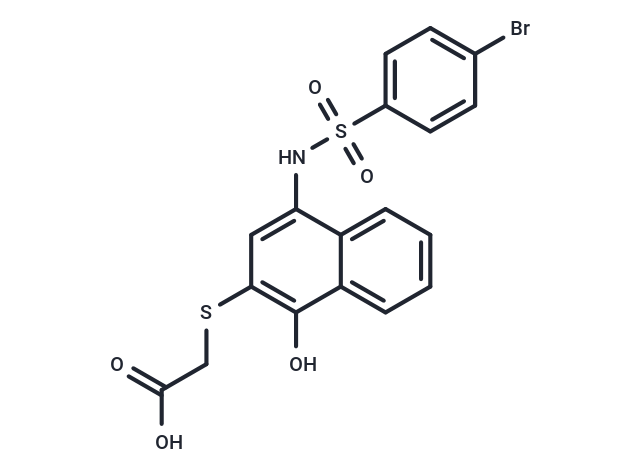Shopping Cart
- Remove All
 Your shopping cart is currently empty
Your shopping cart is currently empty

UMI-77 is a selective Mcl-1 inhibitor. UMI-77 binds to the BH3-binding groove of Mcl-1 with a Ki of 490 nM and is selective over other members of the Bcl-2 family.

| Pack Size | Price | Availability | Quantity |
|---|---|---|---|
| 1 mg | $36 | In Stock | |
| 2 mg | $51 | In Stock | |
| 5 mg | $80 | In Stock | |
| 10 mg | $122 | In Stock | |
| 25 mg | $222 | In Stock | |
| 50 mg | $369 | In Stock | |
| 100 mg | $531 | In Stock | |
| 200 mg | $768 | In Stock | |
| 500 mg | $1,150 | In Stock | |
| 1 mL x 10 mM (in DMSO) | $83 | In Stock |
| Description | UMI-77 is a selective Mcl-1 inhibitor. UMI-77 binds to the BH3-binding groove of Mcl-1 with a Ki of 490 nM and is selective over other members of the Bcl-2 family. |
| Targets&IC50 | MCL1:490 nM(Ki) |
| In vitro | METHODS: A panel of five PC cell lines (MiaPaCa-2, AsPC-1, Panc-1, BxPC-3, Capan-2) with different expression of anti-apoptotic and pro-apoptotic proteins were treated with UMI-77 (1, 10, 100 μM) and the cytotoxic effects were evaluated. RESULTS The IC50 values of UMI-77 against BxPC-3, Panc-1, MiaPaCa-2, AsPC-1, and Capan-2 cell lines were (3.4, 4.4, 12.5, 16.1, 5.5 μM), respectively. [1] |
| In vivo | METHODS: UMI-77 (60, 80 mg/kg, intravenous injection) was used to observe the growth of body weight tumors in the BxPC-3 xenograft model of SCID mice and perform Western blot and immunohistochemical analysis of tumor tissues. RESULTS Treatment with UMI-77 daily for 5 consecutive days per week for two weeks inhibited tumor growth by 65% and 56% on day 19 and day 22, respectively; Western blot of tumor tissue lysates showed slightly increased levels of pro-apoptotic proteins Bax and Bak and significantly reduced survivin. [1] |
| Kinase Assay | Fluorescence polarization (FP)-based binding assays: Based on the Kd values, the concentrations of the proteins used in the competitive binding experiments are 90 nM for Mcl-1, 40 nM for Bcl-w, 50 nM for Bcl-xL, 60 nM for Bcl-2, and 4 nM for A1/Bfl-1. The fluorescent probes, Flu-BID and FAM-BID are fixed at 2 nM for all assays except for A1/Bfl-1 where FAMBID is used at 1 nM. 5 μL of the tested compound in DMSO and 120 μL of protein/probe complex in the assay buffer (100 mM potassium phosphate, pH 7.5; 100 μg/ml bovine gamma globulin; 0.02% sodium azide) are added to assay plates (Microfluor 2Black), incubated at room temperature for 3 h and the polarization values (mP) are measured at an excitation wavelength at 485 nm and an emission wavelength at 530 nm using the plate reader Synergy H1Hybrid. IC50 values are determined by nonlinear regression fitting of the competition curves. |
| Cell Research | Human pancreatic cancer cell lines AsPC-1, BxPC-3, and Capan-2 are cultured in RPMI-1640 medium, whereas Panc-1 and MiaPaCa are cultured in Dulbeccos' Modified Eagle's Medium (DMEM), all supplemented with 10% FBS. The cell growth inhibition after treatment with increasing concentrations of the compounds is determined by WST-8 assay.(Only for Reference) |
| Alias | UMI77, UMI 77 |
| Molecular Weight | 468.34 |
| Formula | C18H14BrNO5S2 |
| Cas No. | 518303-20-3 |
| Smiles | OC(=O)CSc1cc(NS(=O)(=O)c2ccc(Br)cc2)c2ccccc2c1O |
| Relative Density. | 1.79 g/cm3 (Predicted) |
| Storage | Powder: -20°C for 3 years | In solvent: -80°C for 1 year | Shipping with blue ice. | ||||||||||||||||||||
| Solubility Information | DMSO: 86 mg/mL (183.63 mM), Sonication is recommended. H2O: < 1 mg/mL (insoluble or slightly soluble) 10% DMSO+40% PEG300+5% Tween 80+45% Saline: 8.6 mg/mL (18.36 mM), In vivo: Please add the solvents sequentially, clarifying the solution as much as possible before adding the next one. Dissolve by heating and/or sonication if necessary. Working solution is recommended to be prepared and used immediately. Ethanol: 86 mg/mL (183.63 mM), Sonication is recommended. | ||||||||||||||||||||
Solution Preparation Table | |||||||||||||||||||||
DMSO/Ethanol
| |||||||||||||||||||||

Copyright © 2015-2025 TargetMol Chemicals Inc. All Rights Reserved.